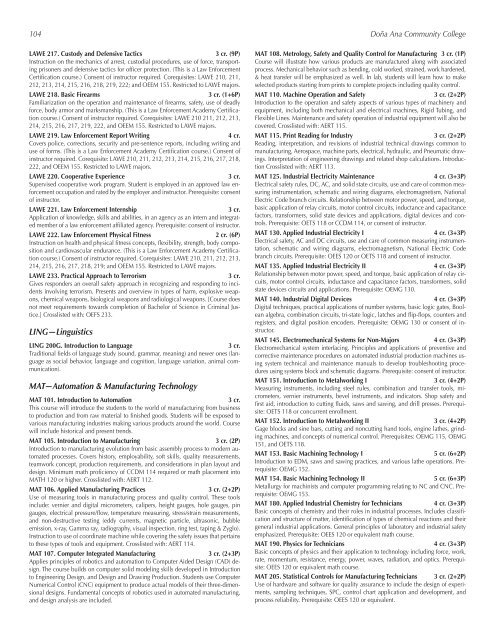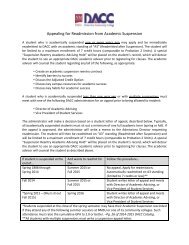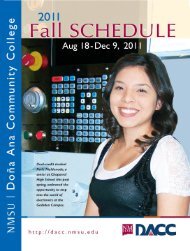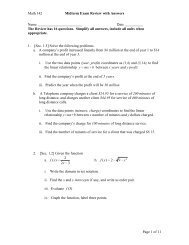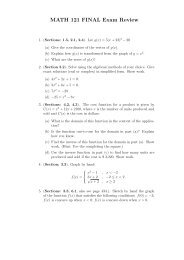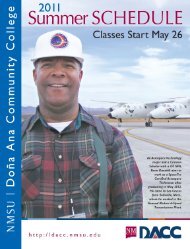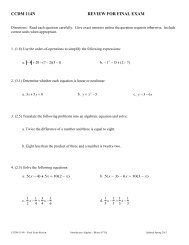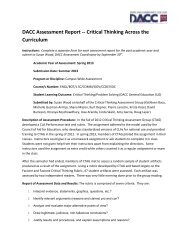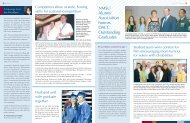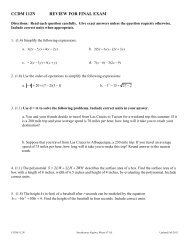DACC Catalog - Dona Ana Community College - New Mexico State ...
DACC Catalog - Dona Ana Community College - New Mexico State ...
DACC Catalog - Dona Ana Community College - New Mexico State ...
Create successful ePaper yourself
Turn your PDF publications into a flip-book with our unique Google optimized e-Paper software.
104 Doña <strong>Ana</strong> <strong>Community</strong> <strong>College</strong>LAWE 217. Custody and Defensive Tactics3 cr. (9P)Instruction on the mechanics of arrest, custodial procedures, use of force, transportingprisoners and defensive tactics for officer protection. (This is a Law EnforcementCertification course.) Consent of instructor required. Corequisites: LAWE 210, 211,212, 213, 214, 215, 216, 218, 219, 222; and OEEM 155. Restricted to LAWE majors.LAWE 218. Basic Firearms3 cr. (1+6P)Familiarization on the operation and maintenance of firearms, safety, use of deadlyforce, body armor and marksmanship. (This is a Law Enforcement Academy Certificationcourse.) Consent of instructor required. Corequisites: LAWE 210 211, 212, 213,214, 215, 216, 217, 219, 222, and OEEM 155. Restricted to LAWE majors.LAWE 219. Law Enforcement Report Writing4 cr.Covers police, corrections, security and pre-sentence reports, including writing anduse of forms. (This is a Law Enforcement Academy Certification course.) Consent ofinstructor required. Corequisite: LAWE 210, 211, 212, 213, 214, 215, 216, 217, 218,222, and OEEM 155. Restricted to LAWE majors.LAWE 220. Cooperative Experience3 cr.Supervised cooperative work program. Student is employed in an approved law enforcementoccupation and rated by the employer and instructor. Prerequisite: consentof instructor.LAWE 221. Law Enforcement Internship3 cr.Application of knowledge, skills and abilities, in an agency as an intern and integratedmember of a law enforcement affiliated agency. Prerequisite: consent of instructor.LAWE 222. Law Enforcement Physical Fitness2 cr. (6P)Instruction on health and physical fitness concepts, flexibility, strength, body compositionand cardiovascular endurance. (This is a Law Enforcement Academy Certificationcourse.) Consent of instructor required. Corequisites: LAWE 210, 211, 212, 213,214, 215, 216, 217, 218, 219; and OEEM 155. Restricted to LAWE majors.LAWE 233. Practical Approach to Terrorism3 cr.Gives responders an overall safety approach in recognizing and responding to incidentsinvolving terrorism. Presents and overview in types of harm, explosive weapons,chemical weapons, biological weapons and radiological weapons. [Course doesnot meet requirements towards completion of Bachelor of Science in Criminal Justice.]Crosslisted with: OEFS 233.LING—LinguisticsLING 200G. Introduction to Language3 cr.Traditional fields of language study (sound, grammar, meaning) and newer ones (languageas social behavior, language and cognition, language variation, animal communication).MAT—Automation & Manufacturing TechnologyMAT 101. Introduction to Automation3 cr.This course will introduce the students to the world of manufacturing from businessto production and from raw material to finished goods. Students will be exposed tovarious manufacturing industries making various products around the world. Coursewill include historical and present trends.MAT 105. Introduction to Manufacturing3 cr. (2P)Introduction to manufacturing evolution from basic assembly process to modern automatedprocesses. Covers history, employability, soft skills, quality measurements,teamwork concept, production requirements, and considerations in plan layout anddesign. Minimum math proficiency of CCDM 114 required or math placement intoMATH 120 or higher. Crosslisted with: AERT 112.MAT 106. Applied Manufacturing Practices3 cr. (2+2P)Use of measuring tools in manufacturing process and quality control. These toolsinclude: vernier and digital micrometers, calipers, height gauges, hole gauges, pingauges, electrical pressure/flow, temperature measuring, stress/strain measurements,and non-destructive testing (eddy currents, magnetic particle, ultrasonic, bubbleemission, x-ray, Gamma ray, radiography, visual inspection, ring test, taping & Zyglo).Instruction to use of coordinate machine while covering the safety issues that pertainsto these types of tools and equipment. Crosslisted with: AERT 114.MAT 107. Computer Integrated Manufacturing3 cr. (2+3P)Applies principles of robotics and automation to Computer Aided Design (CAD) design.The course builds on computer solid modeling skills developed in Introductionto Engineering Design, and Design and Drawing Production. Students use ComputerNumerical Control (CNC) equipment to produce actual models of their three-dimensionaldesigns. Fundamental concepts of robotics used in automated manufacturing,and design analysis are included.MAT 108. Metrology, Safety and Quality Control for Manufacturing 3 cr. (1P)Course will illustrate how various products are manufactured along with associatedprocess. Mechanical behavior such as bending, cold worked, strained, work hardened,& heat transfer will be emphasized as well. In lab, students will learn how to makeselected products starting from prints to complete projects including quality control.MAT 110. Machine Operation and Safety3 cr. (2+2P)Introduction to the operation and safety aspects of various types of machinery andequipment, including both mechanical and electrical machines, Rigid Tubing, andFlexible Lines. Maintenance and safety operation of industrial equipment will also becovered. Crosslisted with: AERT 115.MAT 115. Print Reading for Industry3 cr. (2+2P)Reading, interpretation, and revisions of industrial technical drawings common tomanufacturing, Aerospace, machine parts, electrical, hydraulic, and Pneumatic drawings.Interpretation of engineering drawings and related shop calculations. IntroductionCrosslisted with: AERT 113.MAT 125. Industrial Electricity Maintenance4 cr. (3+3P)Electrical safety rules, DC, AC, and solid state circuits, use and care of common measuringinstrumentation, schematic and wiring diagrams, electromagnetism, NationalElectric Code branch circuits. Relationship between motor power, speed, and torque,basic application of relay circuits, motor control circuits, inductance and capacitancefactors, transformers, solid state devices and applications, digital devices and controls.Prerequisite: OETS 118 or CCDM 114, or consent of instructor.MAT 130. Applied Industrial Electricity I4 cr. (3+3P)Electrical safety, AC and DC circuits, use and care of common measuring instrumentation,schematic and wiring diagrams, electromagnetism, National Electric Codebranch circuits. Prerequisite: OEES 120 or OETS 118 and consent of instructor.MAT 135. Applied Industrial Electricity II4 cr. (3+3P)Relationship between motor power, speed, and torque, basic application of relay circuits,motor control circuits, inductance and capacitance factors, transformers, solidstate devices circuits and applications. Prerequisite: OEMG 130.MAT 140. Industrial Digital Devices4 cr. (3+3P)Digital techniques, practical applications of number systems, basic logic gates, Booleanalgebra, combination circuits, tri-state logic, latches and flip-flops, counters andregisters, and digital position encoders. Prerequisite: OEMG 130 or consent of instructor.MAT 145. Electromechanical Systems for Non-Majors4 cr. (3+3P)Electromechanical system interfacing. Principles and applications of preventive andcorrective maintenance procedures on automated industrial production machines usingsystem technical and maintenance manuals to develop troubleshooting proceduresusing systems block and schematic diagrams. Prerequisite: consent of instructor.MAT 151. Introduction to Metalworking I3 cr. (4+2P)Measuring instruments, including steel rules, combination and transfer tools, micrometers,vernier instruments, bevel instruments, and indicators. Shop safety andfirst aid, introduction to cutting fluids, saws and sawing, and drill presses. Prerequisite:OETS 118 or concurrent enrollment.MAT 152. Introduction to Metalworking II3 cr. (4+2P)Gage blocks and sine bars, cutting and noncutting hand tools, engine lathes, grindingmachines, and concepts of numerical control. Prerequisites: OEMG 115, OEMG151, and OETS 118.MAT 153. Basic Machining Technology I5 cr. (6+2P)Introduction to EDM, saws and sawing practices, and various lathe operations. Prerequisite:OEMG 152.MAT 154. Basic Machining Technology II5 cr. (6+3P)Metallurgy for machinists and computer programming relating to NC and CNC. Prerequisite:OEMG 153.MAT 180. Applied Industrial Chemistry for Technicians4 cr. (3+3P)Basic concepts of chemistry and their roles in industrial processes. Includes classificationand structure of matter, identification of types of chemical reactions and theirgeneral industrial applications. General principles of laboratory and industrial safetyemphasized. Prerequisite: OEES 120 or equivalent math course.MAT 190. Physics for Technicians4 cr. (3+3P)Basic concepts of physics and their application to technology including force, work,rate, momentum, resistance, energy, power, waves, radiation, and optics. Prerequisite:OEES 120 or equivalent math course.MAT 205. Statistical Controls for Manufacturing Technicians 3 cr. (2+2P)Use of hardware and software for quality assurance to include the design of experiments,sampling techniques, SPC, control chart application and development, andprocess reliability. Prerequisite: OEES 120 or equivalent.


